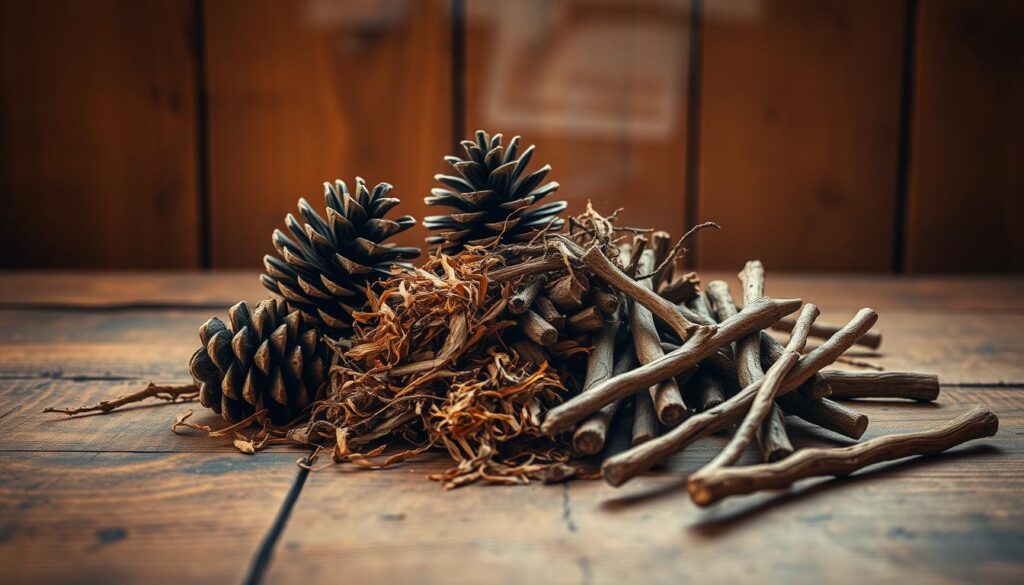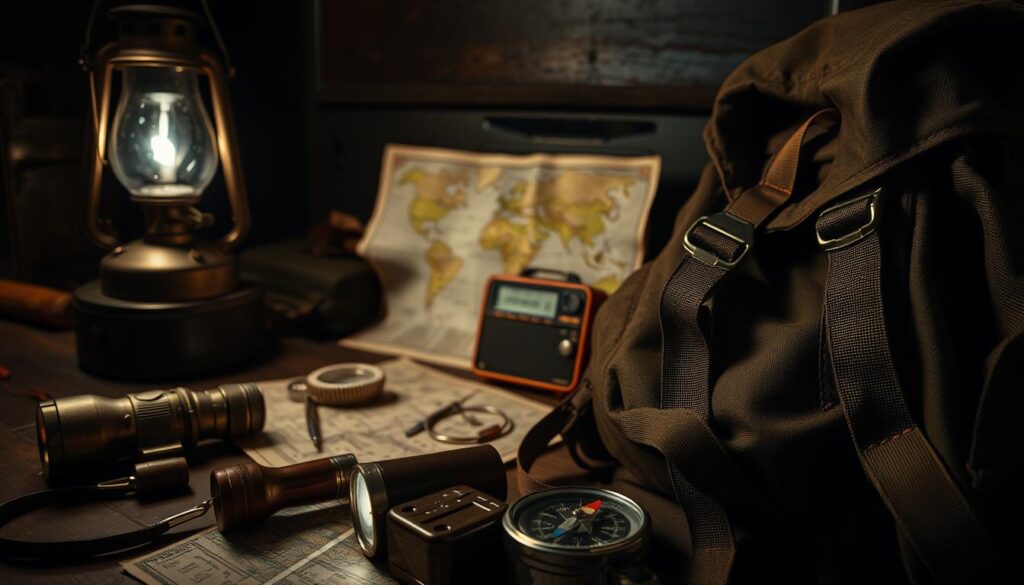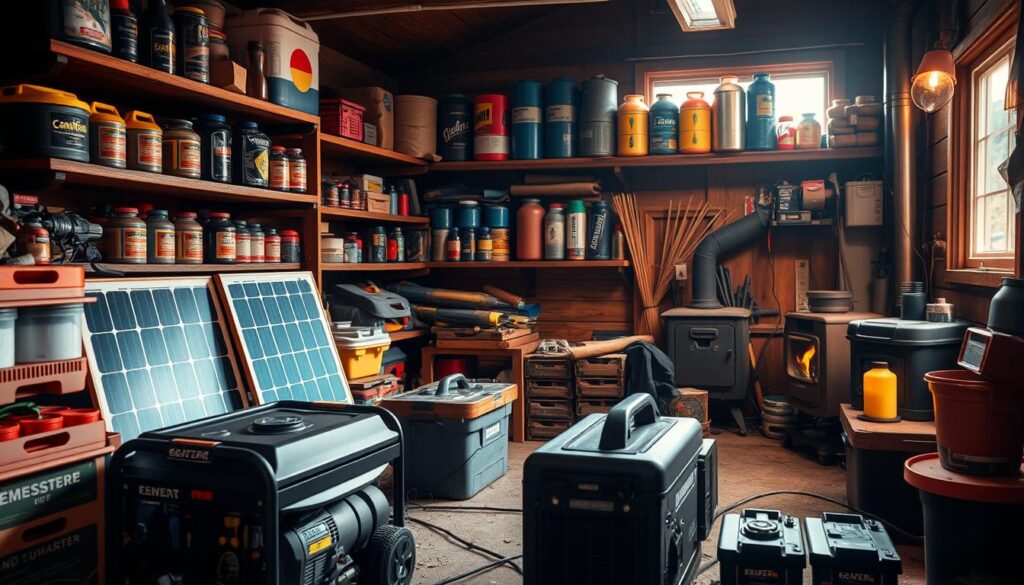Making your own fire starter is a key part of camping. It adds excitement to your outdoor trips. Plus, it teaches you a useful survival skill.
DIY starters are easy to make and save money. You can use items you likely have at home. Many sources say you can make quick ignition devices from common household items.
In this section, I’ll show you how to make your own easy-to-use fire starter. You’ll see how simple and useful this DIY project is.
Key Takeaways
- Create a fire starter using household items.
- Learn a valuable survival skill.
- Enhance your camping experience with a DIY project.
- Understand the simplicity and effectiveness of a quick ignition device.
- Save money by making your own fire starter.
Why I Choose an Easy-to-Use Fire Starter
I’ve tried many fire starters and found one that’s easy to use and reliable. Its simplicity and effectiveness are key, whether I’m camping or hiking.
There are good reasons I like an easy-to-use fire starter. It has a simple design that’s less likely to fail. This makes it a trustworthy choice when you need it most.
- It’s easy to understand and use, even for those new to outdoor tools.
- It needs little upkeep, saving you time and effort.
- It works well in different conditions, without losing its effectiveness.
Another big plus is how it saves time. An easy-to-use fire starter lets me start a fire fast. This is vital for cooking or staying warm outdoors.
- It ignites quickly, saving you time and effort.
- It’s simple enough for anyone to use, making outdoor activities more accessible.
- It lets me focus on other tasks while I’m outside.
Lastly, it’s perfect for beginners. It removes the fear of using complex tools, making it great for newbies to outdoor activities.
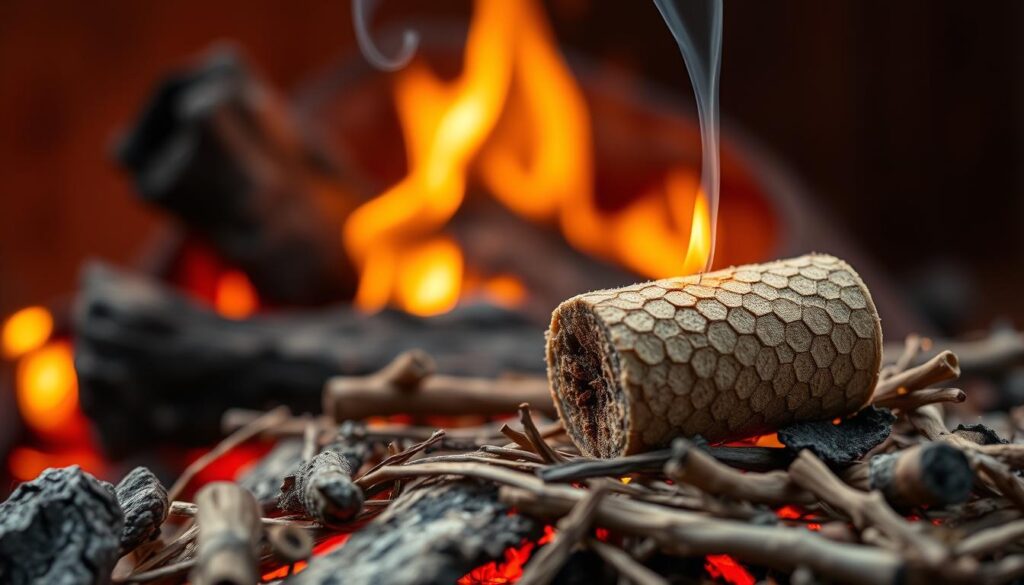
Homemade fire starters are more effective and customizable than store-bought ones. They let you tailor them to your specific needs, making them very versatile.
Essential Materials for My Fire Starter
To make a fire starter, I use common household items and natural ingredients. I need a few simple materials that are easy to find.
Common Household Items
Some of the best fire starters come from everyday items. Dryer lint, wax (like candle wax or paraffin wax), and cotton balls are common in most homes. These items are not only easy to get but also work well to start fires.

Natural Ingredients
Natural ingredients can also make a fire starter better. Sawdust, for example, is very flammable and can be mixed with other ingredients. Dried leaves or twigs can also be used, but they might need extra preparation.
Safety Gear
It’s important to have the right safety gear when working with flammable materials. I wear gloves to protect my hands and safety glasses to protect my eyes. I also work on a fireproof surface. Having a fire extinguisher or a bucket of water nearby is a good safety measure.
For more info on DIY fire starters, check out Backpacker.com. They have tested DIY firestarter recipes.
Step-by-Step Guide to Creating My Fire Starter
To make a durable fire starter, I follow a simple guide. It ensures the fire starter works well. This guide has a few easy steps that need little equipment.
Preparing the Materials
The first step is to gather the needed materials. These include a material that burns easily, a wax or binder, and extra ingredients for better performance or safety.
- Combustible materials like cotton balls or dryer lint
- Wax, such as paraffin or soy wax, to act as a binder
- Optional additives for improved burn time or scent
Mixing the Ingredients
Next, mix the materials together as the recipe calls for. This means melting the wax and mixing it with the burning material and any extra ingredients.
Mixing Tips:
- Make sure the wax is fully melted before adding other ingredients.
- Stir well to get a uniform mix.
Shaping and Drying
After mixing, shape the mix into the fire starter form you want. This could be cubes, spheres, or other shapes that are easy to use.
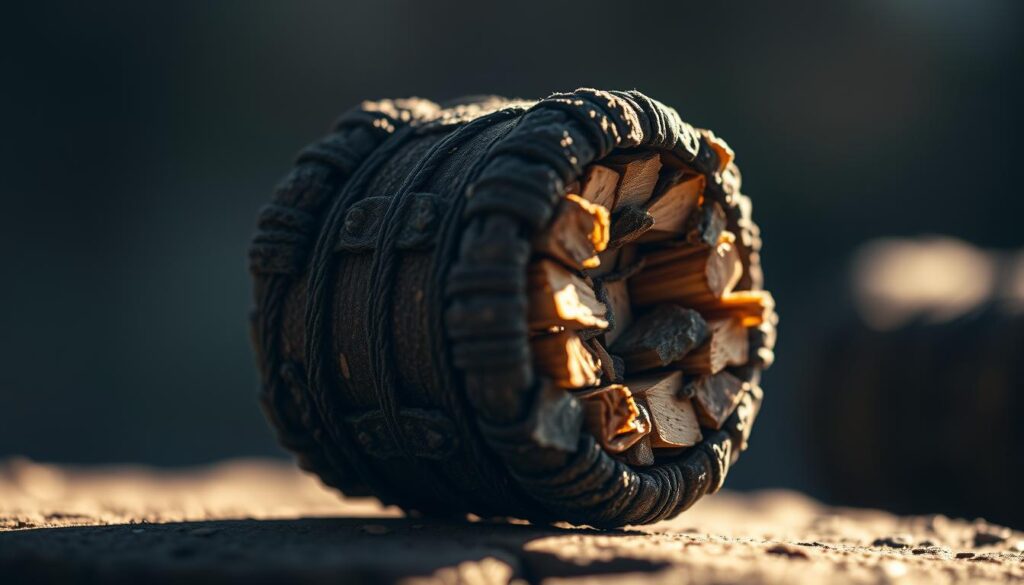
Then, let the fire starters dry and harden. How long they dry depends on their size and the room’s temperature and humidity.
| Material | Purpose | Notes |
|---|---|---|
| Paraffin Wax | Binder | Melts at a relatively low temperature |
| Cotton Balls | Combustible Material | Readily available and easy to use |
| Dryer Lint | Combustible Material | Highly flammable and effective |
Tips for Storing My Fire Starter Efficiently
Storing your fire starter right is key to keeping it working well. It’s important to store it in a way that keeps it in top shape. This makes sure it’s ready to use when you need it.
Container Options
I like to keep my fire starter in airtight containers. This keeps it dry and safe from the weather. You can use plastic containers or metal tin boxes. It’s smart to pick containers made for flammable stuff.
- Plastic containers with tight-fitting lids
- Metal tin boxes with secure closures
- Waterproof bags or pouches
Environment Considerations
The place you store your fire starter matters a lot. I keep it in a cool, dry place, away from sunlight and moisture. This keeps it from getting damaged and keeps it working well.
- Avoid storing near heating vents or radiators
- Keep it away from humid areas like basements
- Store in a shaded area to prevent exposure to direct sunlight
Shelf Life
Knowing how long your fire starter lasts is important. A good fire starter can last months to a year or more. This depends on what it’s made of and how you store it.
To keep it lasting longer, I check on my fire starters now and then. This makes sure they stay dry and safe from the environment.
How I Test the Effectiveness of My Fire Starter
I test my fire starter in a real-world setting. This checks how well it works in different situations.
Setting Up the Test
To start, I pick a safe spot away from anything that could catch fire. It’s also important to make sure the area has good air flow.
I collect my fire starter, tinder, and kindling. I arrange the tinder and kindling in a teepee shape. This helps the fire breathe and grow.
Observing the Results
Next, I watch how fast the fire starter lights the tinder. I also check how long it takes for the fire to reach the kindling.
A good test shows the fire starts quickly and burns steadily. I look at the size of the flames and how much smoke it makes.
Making Adjustments
If the test doesn’t go as planned, I make changes. This could mean adjusting the fire starter’s mix or how I use it.
For example, if it’s hard to light, I might change the ingredients or make sure the tinder is dry.
| Test Criteria | Expected Outcome | Actual Outcome |
|---|---|---|
| Ignition Time | Less than 5 seconds | 3 seconds |
| Flame Sustainability | Steady flame | Steady flame |
| Smoke Production | Minimal smoke | Moderate smoke |
By testing and tweaking my fire starter, I make sure it’s a reliable quick ignition device.
Safety Precautions I Take When Using Fire Starters
When I use my outdoor fire starter, safety is always my top priority. I’ve learned that being cautious and prepared is key to enjoying a safe and pleasant experience around the campfire.
Fire Safety Tips
To ensure a safe experience, I always follow basic fire safety tips. First, I choose a safe location for my campfire, away from flammable materials and overhanging branches. I also make sure to have a bucket of water or a fire extinguisher nearby in case the fire gets out of control.
Another important aspect is monitoring the wind conditions. If it’s too windy, I either postpone my camping plans or look for a more sheltered location. Wind can quickly spread embers and sparks, potentially causing unintended fires.
Proper Ventilation
Proper ventilation is vital when using a fire starter, specially in enclosed spaces. I always ensure that there’s adequate airflow to prevent the buildup of carbon monoxide and other harmful gases. When camping in a tent or enclosed area, I make sure to follow the manufacturer’s guidelines for safe usage.
Emergency Preparedness
Being prepared for emergencies is a critical aspect of using fire starters. I keep a first aid kit handy and know how to treat minor burns and other injuries. It’s also essential to have a plan in place in case of an emergency, including knowing the nearest evacuation routes and having a means of communication.
By taking these safety precautions, I can enjoy using my camping fire starter with confidence, knowing that I’m prepared for any situation that may arise.
Frequently Asked Questions About My Fire Starters
As someone who regularly uses fire starters, I’ve encountered several common questions that I will address in this section.
How Long Do They Last?
The longevity of a fire starter depends on several factors. These include the materials used, storage conditions, and handling. Generally, a well-made compact fire starter can last for several months to a year when stored properly. Keeping mine in a dry, cool place significantly extends its shelf life.
It’s also worth noting that the type of materials used can affect how long a fire starter lasts. For instance, those made with natural ingredients tend to have a shorter shelf life compared to those made with more durable materials.
| Material | Typical Shelf Life |
|---|---|
| Natural Ingredients | 3-6 months |
| Durable Materials | 6-12 months |
Can I Use Them Indoors?
While fire starters are often associated with outdoor use, they can be used indoors under the right conditions. It’s important to ensure proper ventilation to avoid filling the space with smoke or fumes. I’ve used my lightweight fire starter indoors during power outages or when camping in an indoor setting.
It’s essential to follow safety guidelines. Keep a fire extinguisher nearby and ensure that the area is clear of flammable materials.
What Happens in Wet Conditions?
Wet conditions can significantly affect the performance of a fire starter. Most fire starters are designed to be used in various conditions, but excessive moisture can render them less effective or even unusable. I’ve found that a compact fire starter with waterproof or water-resistant materials performs better in wet conditions.
To maintain effectiveness in wet conditions, it’s advisable to store the fire starter in a waterproof container or bag. This helps keep it dry and functional when needed.
Unique Variations of My Fire Starter Recipes
I’ve been on a journey to find the best fire starter. Along the way, I’ve tried many recipes. Each one has its own special benefits. This journey has helped me make fire starters that last longer and work better.
Eco-Friendly Options
Using eco-friendly materials has greatly reduced the harm to our environment. For example, recycled materials or natural waxes make fire starters more green. Here are some eco-friendly choices:
- Using natural fibers like cotton or hemp for the starter’s core.
- Incorporating recycled paper or cardboard into the recipe.
- Opting for soy wax or other plant-based waxes instead of paraffin wax.
Scented Fire Starters
Scented fire starters add a nice smell to the mix. I’ve tried different essential oils to make fire starters that smell good. They also help start fires easily and make the air fresh. Popular scents include lavender, pine, and cinnamon.
High-Performance Alternatives
If you want fire starters that burn longer and hotter, I’ve got you covered. I’ve made recipes with materials that burn better. These include denser materials or special chemicals to improve burn time and heat.
Final Thoughts on My Easy-to-Use Fire Starter
Thinking back on my time with an easy-to-use fire starter, I see how much it’s changed my outdoor fun. This tool has made starting fires simple and fun. It’s made my outdoor adventures better and easier.
Making my own fire starter was a fun DIY project. It also taught me a lot about safety and being self-sufficient. It’s shown me how important it is to know how to start fires safely.
I think everyone should try making their own fire starter. It’s easy with just a few materials and some basic steps. The feeling of making something useful and enjoying a fire is priceless.
If you love the outdoors or just like being ready for anything, making a fire starter is worth it. It’s a fun project that brings warmth and light. So, give it a shot and enjoy the fire.
FAQ
How long do homemade fire starters last?
Homemade fire starters can last from months to a year. This depends on the materials and where you store them. Keep them in a dry, cool spot.
Can I use homemade fire starters indoors?
You can use them indoors, but make sure there’s good air flow. This prevents inhaling harmful fumes. Always follow fire safety rules and local laws.
How do homemade fire starters perform in wet conditions?
Their performance in wet conditions varies by material. Some, like wax, might work even when damp. But, always test them first in damp conditions.
Are homemade fire starters safe to use around children and pets?
They can be safe if you handle them right. Keep them away from kids and pets. Always use caution when using them.
Can I customize my homemade fire starter recipe?
Yes, you can try different ingredients to make your own. Use various waxes, sawdust, or other materials. This way, you can make them eco-friendly, scented, or more effective.
How do I store my homemade fire starters to maintain their effectiveness?
Store them in a dry, cool place. Keep them away from sunlight and moisture. Use airtight containers or zip-top bags to keep them fresh.

